I’ve noticed that a good number of people come here looking for pictures and ideas for building a goat head catch or milking stand at home. I’ve included some pictures in my previous Goat 101 posts, but I wanted to devote an entire post to this subject, since it is a simple project you can do at home, often with scrap lumber.
First off, is a milking stand really even necessary? For us personally, yes it is. Although I can milk our goats while they are tied up or someone is holding them, I find that it is infinitely easier and more sanitary for us to use a stand. Since milking is something I do every single day, I like to streamline it as much as possible. However, if you have the perfect goat who quietly grazes and stands while you milk her out in the pasture, more power to you!
There are several places online where you can find detailed plans to build a milking stand of your own (Fias Co Farms is an excellent resource).
However, my hubby is quite the carpenter already, so when we were preparing to build our stand, he just needed pictures and ideas, not precise measurements. This is definitely not an exact science, do what works best for you and your goats! He checked out a few different photos, and then whipped out this stand in a couple hours.
Here is a side view. We have rather large Nubians and built it to accomodate their size. The legs are 12″ high.
The base/floor is 19″ wide and 36″ long. It’s made from heavy OSB board.
The back view of the open head catch. The goat jumps up and places her head through the hole so she can eat her grain.
I then close the catch and secure it with a small piece of rebar that slides in a hole. I thought this was a pretty brilliant design that hubby came up with- it saved us from having to run to town and purchase any latches or hooks.
A close up of the hole, minus the rebar rod.
Front view of the open head catch with grain bucket, it’s approximately 36″ tall. You can just barely see it, but the handle at the top is a large branch that we wedged into a hole into the top of the 2×4.
A close up of the moving portion of the head catch. The 2×4 on the right is stationary, it doesn’t move. The 2×4 on the left pivots on a large bolt.
I’ve found that I don’t need a stool to milk. I just sit on the edge of the stand. A stand is also very handy to have if you are trimming feet, giving shots, or clipping.
But I hope this will give you some ideas as you build a milking stand or goat head catch for your homestead!
For those who already have stands, any cool design tips or tricks you could share?
Can’t get enough goat? Then check out some of the other popular posts in the Goat 101 series:
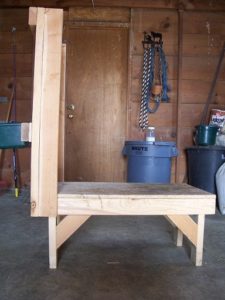
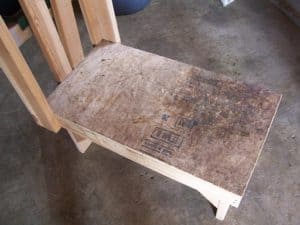
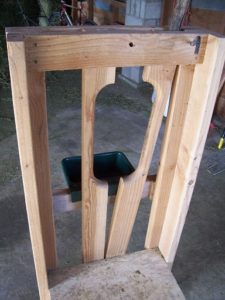
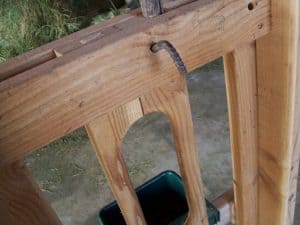
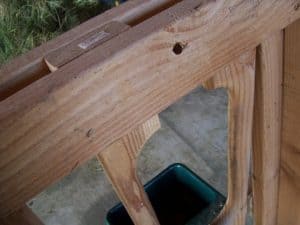
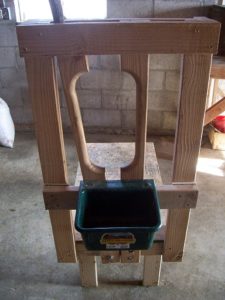
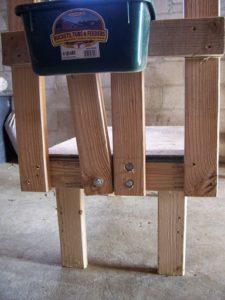

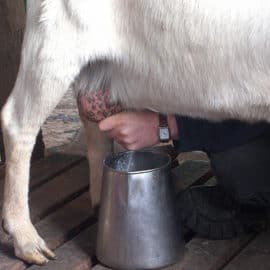

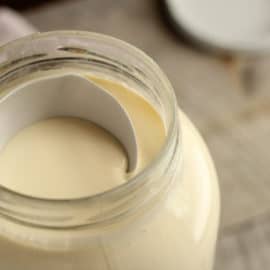
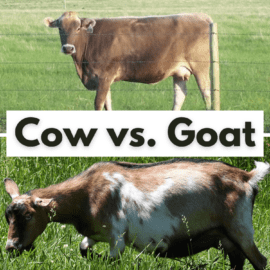
My grandpa has milked goats for many years and uses the same idea where the goats put there heads in to eat grain and then he moves over a bar and latches it. I will have to send you a photo. His is set up to where he can milk multiple goats at a time. Your husband was very creative and done a great job building that.
Sarah
We are building our goat shed now and the milking stand is next. Thanks for the detailed pics. Hubby does work in aluminum so I think he is going to make it out of that.
An aluminum one would be super easy to clean- what a great idea!
Very nice stanchion! Mine is along those lines but not quite as refined. I’d really like to have what Sarah mentioned – a multi-goat stand.
Joyce- so would I! Would definitely save some time loading and unloading each goat. 😉
Great timing on this post…building one of these is next on our list. Gotta get it done before we pick up our goats at the end of the month! I’ve really appreciated all your posts in the Goats 101 series as I try to absorb all I can in preparation for their arrival.
Hi Ginger-
I’m so excited for you to get your goats. And I’m glad that the Goat 101 series has been helpful to you. 🙂
Hi Jill!
Is there somewhere where I can see all of your blog posts for Goat 101? I’d love to read the whole series.
Thanks!
Mary
Thank you so much for sharing this on Simple Lives Thursday! Your milk stand is perfect timing as our first doe just had her first kid! I need to start milking her now. Question: How long do you let your kids nurse before starting to separate them to get the milk? Right now our kid is one week old and nurse great. Our doe hardly has milk leftover because he sucks it all up! LOL!
Hi Marillyn!
I wait around 2 weeks before I start separating the kids so I can milk. It seems to give everyone a chance to recover from the birth experience. Congrats on your first goat baby- it’s so exciting! 🙂
I think I might have to show this to my dad (aka my favorite carpenter)!
If only I didn’t live in an apartment and had a house, I would attempt this in a heart beat!
Well, you could always try apartment goat keeping- maybe start a new trend? hehe j/k! 🙂
Wow, this is amazing ! I am bookmarking this for the future, as we plan to purchase goats within the next five years (that fencing is what we have to get ready!!)
Hi, I just came across your site tonight in search for plans for a milking stanchion. I have one little lamancha and I love your stanchion but I’m just wondering if it would be too big for her? Thanks again, loved all the pictures, your stand is beautiful!
You can definitely custom build the stand according to the sizes of your goats. All you need to do is adjust the space of the head catch. Good luck!
we make several holes for the pin (love the rebar-we use a bolt) so it can fit anything from kids to chubby mature goats. We don’t have that nice shaping on the 2x4s, just two parallel pieces, with more space between them at the bottom than yours.
Here is ours that my husband made for “free”. http://www.homesteadfailure.blogspot.com/2011/09/chickens-in-your-goat-milking-stand.html My favorite part of ours is that we have goat-proof, chicken-proof, mouse-proof, rain-proof storage.
We raise Nigerian show and production Nigerian Dwarf goats in SE TX. We have been at it for 5 years, but started with a very wild Pygmy doe. We used to let the whole herd mill around and jump on the stand while we worked on them at trimming or vaccination time. Plus we have gone through some pretty rank milkers, like the boer we trained to milk last year that fell on my lap and bounced right out of the milk bowl back onto the stand. All this can be pretty tough on a stand. This looks a bit top-heavy, so placing it against a fence or better, in a corner, could keep it from tipping if all the goats get loose and run over there and try to jump up on it at once. They tend to fight and jump up and butt each other, and they use a lot of force when they do.
Another tip, might be to make both sides moveable in case you need to work with a horned animal occasioanlly. They are the ones that most need to be in a headgate.
Yes, I forgot to mention that I always use it pushed up against a wall. The does like to be able to lean on the wall, anyway.
Good day,
Initially I wrote to thank you for the milking stand 4-1-1 then I read your short bio at the bottom of your webpage. You are living the life to which I aspire and my hat goes off to you. We are off the grid and this is my first experience with that we are trying to accomplish. I am excited and it cracks me up to see folks faces as they discuss our lifestyle with them.
To be sure I will be reading your blog through and through. Thank you for sharing with the rest of us.
Lyric
P.S. You go girl with that killing rattlesnakes and all.
I really hope to be off the grid someday, but we aren’t quite there yet. So glad that you found the milking stand post useful! I look forward to seeing you around the blog. 🙂
I used to milk goats and I found that if I just put the grain in the tub, my does would jump up on the stand and scarf the grain down as fast as they could-sometimes finishing before I even got their teats cleaned off. Then they were done and wouldn’t stand still for milking without more grain! what I ended up doing was mixing their grain into a crunched up leaf of alfalfa and it took them a lot longer to root around for the grain and munch the alfalfa leaves so I had time to finish milking! Loved my goats, I wish I could still have them!
I love the pics of the milking stand. My husband is also a very handy guy. He built mine 3 years ago after seeing one the lady from whom I got my goats had. He can weld and cut medal so he made mine from angle iron and just bolted it together. We found a rubber mat at TSC and use it on the top of the flooring of the stand. That way my girls don’t slip when they jump up and I can remove it to clean. It has saved the wood from being so wet. I love your posts and want to say Thanks for sharing.
Gotta love those handy hubbies! 🙂
Ours is very similar to yours in design, but with very limited space (in the basement) we made a few modifications. Along the back edge we left off the legs, added hinges, and attached it to the wall. The front legs run up to be the sides of the head catch. The head catch is a piece of plywood with two V’s cut out (attached to the “inside” of the legs). 2 chains are attached in-between the V’s with hooks on the sides of the legs. The goats put their heads into the V, the chain goes across and they can’t remove their heads. We did this initially because my first goats had horns, but it works without horns too. A 2×4 across the front of the head catch attached to the legs holds the feed bucket. The front leg section is also hinged to the base. When raised the base is flat against the wall, the front section is flat against the base and I have my floor space back! A hook on one of the legs, an eyescrew on the wall (large), and a spring (attached to the side of the base and the wall) to help ease the stand up to the wall (and down) makes it easy for the kids to do it too.
On a side note, although it holds 2 goats, I found they got impatient waiting their turn and caused more problems with pushing on each other. So I do them one by one now. Much calmer that way. Hope this helps or inspires someone working on their own stand!
Sounds like you made some great modifications! Thanks for sharing your tips!
Hello it’s me, ? am als? visiting this web page on a regular basis, this
website is genuinely nice and the users are actually sharing good
thoughts.
love it
Thanksss
What are the dimensions of the head opening.?